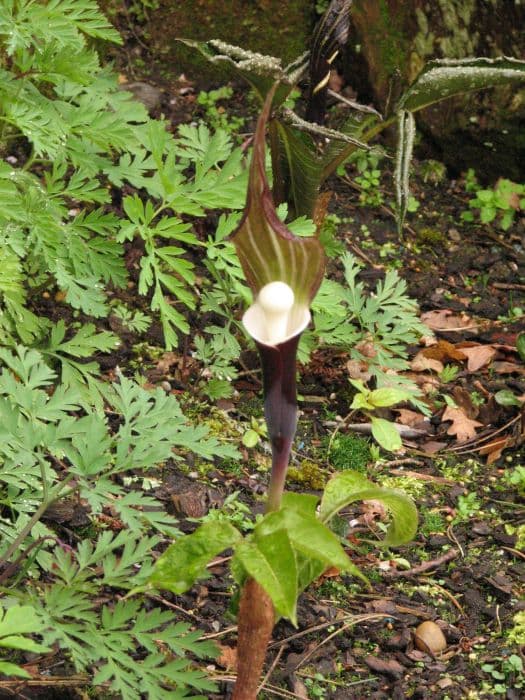Pheasant Tail Anthurium schlechtendalii
















ABOUT
Anthurium schlechtendalii, commonly known as pheasant's tail, is a tropical perennial with a distinctive appearance. Its foliage is notable for being quite large, heart-shaped, and possessing a glossy texture which gives it a lustrous look in the light. These leaves are deep green and sometimes have a velvety sheen. This lush appearance is often accented by the pronounced leaf veins that ripple across the surface, providing both texture and visual interest. The plant is also well-known for its flowers, which are not typical blossoms but rather a type of inflorescence called a spadix, accompanied by a colorful, leaf-like bract known as a spathe. The spadix is a finger-like projection that emerges from the center of the spathe and it bears the tiny true flowers of the plant. In the case of the pheasant's tail, the spadix is usually a pale color, blending in with its surroundings, while the spathe can be a striking contrast, often in different shades of red or burgundy that adds to its exotic appearance. The combination of these dark, waxy leaves and the contrasting inflorescence makes the pheasant's tail a sought-after plant for both indoor plant enthusiasts and gardeners in tropical settings. Its unique form and coloration have made it a popular choice for adding a touch of elegance and tropical flair to living spaces.
About this plant
 Names
NamesFamily
Araceae.
Synonyms
Pheasant Tail, Anthurium.
Common names
Anthurium venosum, Pothos schlechtendalii, Anthurium pyramidale.
 Toxicity
ToxicityTo humans
Laceleaf, when ingested by humans, can be toxic. It contains calcium oxalate crystals, which can cause irritation to the mouth, throat, and gastrointestinal tract. Symptoms of poisoning may include burning and swelling of the lips, mouth, and tongue, difficulty swallowing, and possible upset stomach or vomiting. In severe cases, ingestion can lead to difficulty breathing due to swelling of the throat.
To pets
Laceleaf is also toxic to pets, including dogs and cats, due to the presence of insoluble calcium oxalate crystals. If a pet ingests any part of the plant, symptoms can include oral irritation, intense burning and irritation of the mouth, lips, and tongue, drooling, vomiting, and difficulty swallowing. In severe cases, it can cause respiratory problems if swelling obstructs the airway.
 Characteristics
CharacteristicsLife cycle
Perennials
Foliage type
Evergreen
Color of leaves
Green
Flower color
Green
Height
1-2 feet (30-60 cm)
Spread
1-2 feet (30-60 cm)
Plant type
Herb
Hardiness zones
11
Native area
Mexico
Benefits
 General Benefits
General Benefits- Decorative Appeal: Anthurium schlechtendalii, also known as pheasant's tail, has distinctive, long green leaves that can add an exotic and tropical flair to any indoor or outdoor setting.
- Low Maintenance: It is relatively easy to care for, requiring minimal attention beyond regular watering and occasional fertilizing.
- Humidity Tolerance: The pheasant's tail thrives in humid conditions, making it well-suited for bathrooms or other areas where moisture levels are higher.
- Longevity: This plant has a long lifespan when properly cared for, providing years of enjoyment.
- Shade Tolerance: It can tolerate low-light conditions better than many other houseplants, though it does best in bright, indirect light.
- Symbolism: Often associated with hospitality and warmth, adding it to a living space can create a welcoming atmosphere.
 Medical Properties
Medical PropertiesThis plant is not used for medical purposes.
 Air-purifying Qualities
Air-purifying QualitiesThis plant is not specifically known for air purifying qualities.
 Other Uses
Other Uses- Anthurium schlechtendalii leaves can be used to create a natural green dye for fabrics, providing an eco-friendly coloring option.
- Cut leaves of the Laceleaf can serve as decorative elements for tropical-themed events or floral arrangements.
- The plant's sturdy leaves can be fashioned into temporary containers or wrappers for small items, taking advantage of their large size and flexibility.
- Laceleaf plants are sometimes used in vivariums or terrariums, as they can thrive in high-humidity environments and are non-toxic to many reptiles and amphibians.
- The stiff, waxy leaves of the Laceleaf can be used in crafting, specifically in creating textured impressions in clay or plaster.
- With its attractive shape and long-lasting freshness, the Laceleaf can be used as a living decoration or temporary jewelry, such as a corsage or boutonniere.
- In regions where the Laceleaf is native, the plant may be used in traditional ceremonies or rituals as a symbol of hospitality or abundance.
- The extensive root system of the Laceleaf can be used in erosion control to help stabilize soil in areas prone to landslides or heavy rain.
- Environmental educators might use the Laceleaf as an example to teach about epiphytism, as the plant is known to grow on other trees without harming them.
- Enthusiasts of naturalist art or botanical illustration often choose the Laceleaf as a subject due to its interesting form and texture.
Interesting Facts
 Feng Shui
Feng ShuiThe Laceleaf is not used in Feng Shui practice.
 Zodiac Sign Compitability
Zodiac Sign CompitabilityThe Laceleaf is not used in astrology practice.
 Plant Symbolism
Plant Symbolism- Love and Hospitality: Often referred to as "Flamingo Lily," Anthurium schlechtendalii is widely considered a symbol of love and hospitality due to its open, heart-shaped flower and welcoming appearance.
- Exotic Beauty: With its striking appearance and tropical origin, the Flamingo Lily represents exotic beauty and uniqueness in the plant world.
- Long-lasting Relationships: Anthuriums have a long vase life, which makes them a symbol of enduring relationships and lasting affection.
- Good Fortune: In some cultures, giving an Anthurium plant is thought to bring good luck and fortune to the recipient.
- Wealth and Prosperity: The lush, glossy appearance of the Flamingo Lily leaves is sometimes associated with abundance and prosperity.
 Water
WaterWater your Anthurium, commonly known as the Laceleaf, with approximately 6 ounces of water every week. The frequency can vary slightly depending on the humidity and temperature of your home. Ensure the soil is consistently moist but never waterlogged, as Laceleaf is susceptible to root rot. If the top inch of soil feels dry, it's time to water again. During the winter months, reduce the watering slightly as the plant's growth slows down.
 Light
LightLaceleaf thrives in bright, indirect light conditions. Place it near a window that receives plenty of natural light but is shielded from direct sunlight to avoid scorching the leaves. An east or north-facing window is often an ideal spot for a Laceleaf.
 Temperature
TemperatureLaceleaf prefers warm temperatures between 60 and 90°F. It should not be kept in temperatures below 50°F as cold drafts and sudden temperature drops can damage the plant. The ideal temperature range for Laceleaf's growth is 70-85°F.
 Pruning
PruningPrune your Laceleaf to remove any yellow or damaged leaves and to promote bushier growth. This is best done in the spring or early summer. Pruning can be performed every few months or as needed to maintain the desired shape and size of the plant.
 Cleaning
CleaningAs needed
 Soil
SoilThe Laceleaf prefers a light, well-draining soil mix rich in organic matter, with a pH between 5.5 and 6.5. A good mix could consist of peat, pine bark, and perlite in equal parts to ensure proper moisture retention and aeration.
 Repotting
RepottingThe Laceleaf should be repotted once every two to three years or when it becomes pot-bound. Spring or early summer is the best time for repotting to allow the plant to adjust and grow in the new container.
 Humidity & Misting
Humidity & MistingLaceleaf thrives in high humidity environments, ideally between 60% and 80%. To maintain optimal humidity levels, regular misting or a humidifier may be used.
 Suitable locations
Suitable locationsIndoor
Provide bright, indirect light and high humidity for Laceleaf indoors.
Outdoor
Keep the Laceleaf in partial shade and protect from cold drafts outdoors.
Hardiness zone
11-12 USDA
 Life cycle
Life cycleThe Laceleaf (Anthurium schlechtendalii) begins life as a seed, typically dispersed by birds or other animals that have eaten the fruit of a mature plant. Upon finding a suitable environment with warmth, moisture, and indirect light, the seed germinates and a small seedling emerges. The seedling establishes a root system and grows into a juvenile plant, putting out characteristic heart-shaped leaves and developing the central stalk. As it matures, the Laceleaf starts to produce its own inflorescences, consisting of a spadix and spathe, which are often mistaken for flowers but are in fact a bract surrounding a flower spike. Once pollinated, the spadix produces berry-like fruits containing seeds, thus completing the reproductive cycle. Finally, the plant reaches the end of its life cycle which can span several years, after which it will die back, having potentially produced several generations of offspring through seed dispersal or vegetative propagation if conditions are favorable.
 Propogation
PropogationPropogation time
Spring-Early Summer
Anthurium schlechtendalii, also known as pheasant's tail, can be propagated effectively through division, which is the most popular method of propagation for this plant. The ideal time for propagation is during spring or early summer when the plant is actively growing. To propagate by division, carefully remove the plant from its pot and separate it into smaller sections, ensuring that each section has at least one healthy stem and root system. Replant the divisions into individual pots filled with a well-draining potting mix. Water the new plants lightly to settle the soil around the roots, using about a cup of water (approximately 240 milliliters) for each pot, and maintain consistent humidity until new growth indicates successful establishment.









